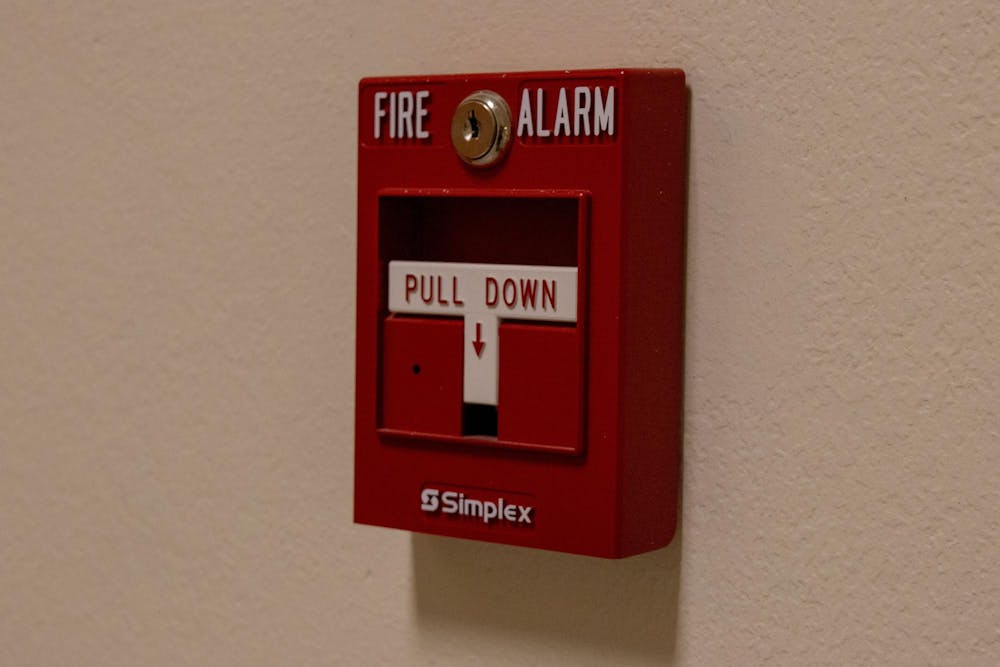It is a familiar story on campus: the ringing bells, the loud alarm and the evacuation process — all to find someone burned their popcorn in the microwave.
A typical false fire alarm causes disruption. For students, it is annoying to waste their time or to lose sleep, but for the Bloomington firefighters who rush over at a minute’s notice, fully geared, sirens blaring, it ends up costing a lot more.
It cost the Bloomington Fire Department exactly $40,017.91 to respond to 135 false alarms from Indiana University dorms from July 1, 2023, to June 30, 2024, according to the Bloomington Fire Department Deputy Chief Max Litwin. Of the department’s 6,574 emergency calls during that period, 815 — or 12% — were to IU.
That cost is a conservative estimate, based only on one of two units that respond to alarms at dorms. Litwin said the number is only reflective of the first unit and would be higher if the second unit was factored in.
Litwin said IU has a fixed contract with the BFD, in which IU pays for a portion of Bloomington Fire Station #3 staffing, funding a variable number of personnel hours. IU’s contract with Fire Protection Services cost $1,357,952 in 2024, which is 7.51% of the BFD’s 2024 budget, according to the fire department. That amount of money in the contract does not fluctuate with rising calls, due to the fixed contract.
While the number of IU calls remains mostly the same year over year, Litwin noted that the number of false alarms in 2023-2024 went up from previous years.
The first responding unit spent an average of 15 minutes responding to each false alarm, with each trip averaging $296.43 in cost for personnel, apparatus and equipment charges. Litwin clarified the second unit's time is variable, due to the first unit sometimes being able to call them off if there is an immediate sign of a false alarm.
False alarms are not the end of it for the fire department, as malicious alarms, alarms pulled with criminal intent, creep higher in costs due to the increased time spent for the crew. BFD responded to four malicious alarms at IU last year, resulting in an average charge of $525.40 and an average time spent of 26 minutes. Litwin said that calculating costs for malicious alarms are not always easy as they involve a “level of criminal investigation” with the police department.
According to Litwin, the correlation between calls and provided funds does not mean that IU is underpaying the fire department, although the fire department would bear the brunt of the cost of excessive false alarm calls.
There is a statistical outlier where the excessive calls originate. According to the department's data, Forest Quadrangle accounted for 36% of false alarms out of the thirteen dorms during the year-long period.
Forest is one of the only dorms to offer student kitchens on every floor, and with kitchens comes burnt, smokey food, which was the most frequent offender for triggering false alarms.
“I could almost tell you what food it is because I’ve smelled so many burnt popcorns and burnt ramen and burnt everything else,” Litwin said.
Litwin said BFD’s community engagement officer has reached out to IU about coordinating first-year food information services to combat the high number of false alarms but is "unsure” of the current standpoint of any programs.
Aryana Amin-Tehrani, a resident assistant at IU, said that during training, RAs learn about fire safety, and they mention it. Amin-Tehrani personally mentioned it in their first-floor meeting.
“It's a bunch of freshmen, and maybe in the kitchen more than (they) were in high school,” Amim-Tehrani said.
Litwin said he was worried about students not responding to real fire alarms in dorms with a high number of false ones. The safety of students is a priority for the firefighters, Litwin said, and false alarms create a situation that can harm that safety.
“It spikes a little bit of fear for if there were ever to be a serious incident, how many innocent folks are still in the building and what could result from that?” Litwin said.




